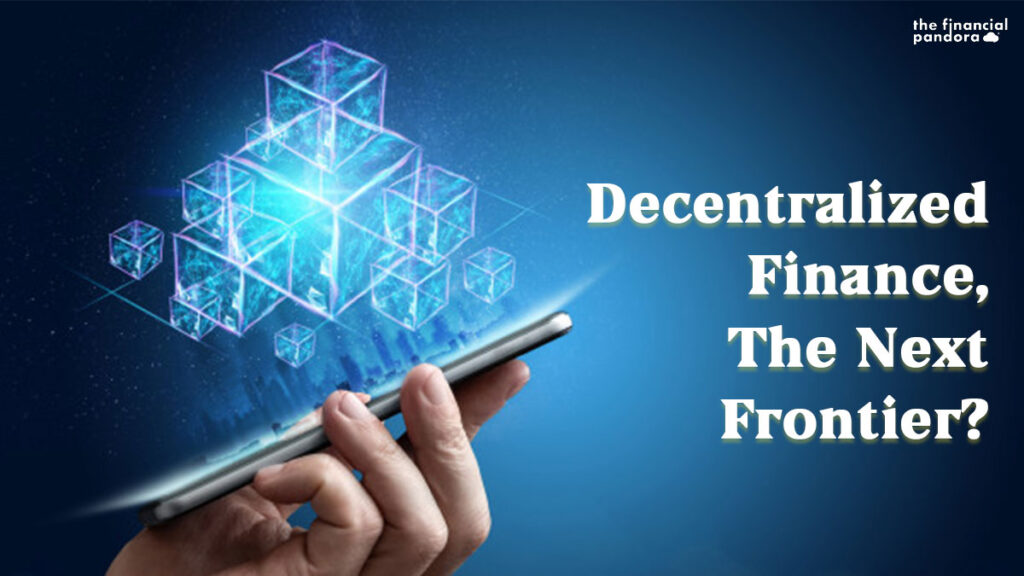What is a Bank? You would say it is an institution with which you deposit your wealth to be safe and generate interest. This definition is centuries-old by now. But the bank of the 21st century is unlike any other institution. Banking of the 21st century will leave the Medicis scratching their heads in bewilderment.
Banking as a practice has undergone numerous transitions, i.e., from Cash to Cheques to Cards to UPI. At the same time, the ability to make a payment has also gone through multiple iterations. Every time a new advancement is made, the transactions became faster, cheaper, and most importantly, more convenient for the user. Every such transformation is like a revolution. Every new iteration fundamentally changes how we interact with money and make a transaction.
What can be the next frontier of Finance?
Enter Decentralized Finance or DeFi to stake its claim.
What is Defi?
Decentralized Finance is a system that enables you to transact, invest and save without any traditional intermediary, where the only thing you require is a smartphone and internet access. While at first glance, you may look at DeFi as an incremental improvement over the existing financial systems, the frameworks of DeFi are entirely new. Before we understand how Defi works, let’s know how transactions have always worked till now:
In the traditional system, you go through the following steps,
i. You deposit money in the bank and provide instructions
ii. Your bank transfers the money
iii. Your buddy goes to his Bank/Atm to withdraw the same
It is that simple. Or is it?
While the traditional approach stays the same, any transaction requires a bank as a middleman to facilitate the trade. Every such transaction is routed through the banking system, which requires multiple parties, multiple personnel, expending time, and incurring a cost. But DeFi can change that. In a DeFi Financial system, the transactions are conducted on a peer-to-peer basis sans any middleman.
i. You open your e-wallet on your phone
ii. You enter your friend’s e-wallet address, et voila.
In this system, since you send the money directly to your buddy without any intermediary, the transactions become faster, efficient, cheaper, and more accessible. Since DeFi uses blockchain tech, it also makes the system much more transparent.
Steps to Decentralized Finance?
The concept of Decentralized Finance was always theocratized. Bitcoin’s blockchain tech and its ability to host decentralized transactions became the first real-life example, allowing users outside the crypto circles to understand better and accept the concept.
After blockchain, the Ethereum network’s intelligent contract feature is the second enabler of DeFi. I would quote from my previous article, “Ethereum has the feature where you can program smart contracts, allowing them to make immutable financial agreements. These contracts can also act as a registry ensuring rightful ownership for any physical or digital assets.”
In Ethereum smart contracts, the Code is Law. Only if both parties consent to the terms can they enter into the contract. After the contract has been signed and consent, it becomes the smart contract’s responsibility to ensure the execution to the word, which happens without any human intervention. Here blockchain shared ledger makes sure that no alteration to the contract is possible later by anyone ensuring its security.
You may read about Ethereum and the working of Smart Contract in my article here:
Decentralized Lending with MakerDAO
MakerDAO is credited with getting the talk started on DeFi. Maker Foundation is also behind the launch of their cryptocurrency called DAI. DAI is a stable coin that aims to keep its value pegged to the US dollar where
1 DAI = 1 US $
DAI is created when one collateralizes Ether (the cryptocurrency of Ethereum) using MakerDAO. On this collateralized Ethereum asset, one may take out up to 66.67% of the collateral value as a loan. This Ethereum will generate an interest in the form of additional DAI, which you can borrow later. But suppose the value of the Ethereum declines less than this 66.67% threshold, the smart contract automatically liquidates your collateral with the MakerDAO to pay back the lenders.
While cryptocurrencies are known for the fluctuations in their value, stable coins can be the first step to provide the stability everyone looks for in a currency. Maker Foundation, the developer behind MakerDAO, promotes DAI as the community-run investment fund. Making a deposit and taking a loan were the two services that got the banking system started. DAI could be one of the working examples of How Decentralized Lending may work in the future. Its proof-of-concept, accomplishments, and future possibilities require their separate article.
Other Possibilities
According to the Ethereum website, Ethereum wishes to leverage its following capabilities, which could make this DeFi a reality:
i. Blockchain capabilities,
ii. Ether Currency,
iii. Smart Contracts enforceability
iv. Platform hosting for Decentralized Apps (DAPPS)
According to the Ethereum website, if a person can leverage these Ethereum capabilities, all the following activities are possible:
i. Sending money across the Globe
ii. Pay your rent/dues across the Globe
iii. Borrow Funds with collateral
iv. Trade Cryptocurrencies
v. Secure funding for your ideas
vi. Insurance
Concerns before Mass Adoption
Decentralized Finance is still in the nascent stage of its adoption. While its most prominent supporters are its initial adopters who understand the tech and could imagine the real-world possibilities of its services, mass adoption would still take time.
The biggest driver for any system adoption is the trust of the people in that system. DeFi is a revolutionary idea, but a person who may not understand the tech or the financial background would treat DeFi as simply an option. While understanding how directly sending money to someone is cheaper than sending it through the bank, the stories of hackers finding a loophole in code have made their way across users. Thus, this delays his decision to adopt this new system due to a lack of trustworthiness.
On the regulations front, existing laws exist according to the traditional financial system. Their definition and enforceability would need to be adapted w.r.t. DeFi with the appropriate authorities, which is a long and tedious process in itself.
DeFi is expected to be the future. Every new height cryptocurrencies reach, every system like Ethereum is made, and every use case like that of MakerDAO takes a step towards mass adoption; while the initial step may be slow, but once we reach the critical point, the growth will be unfathomable.
For sources click here
Follow Us @





Very well presented…thanks